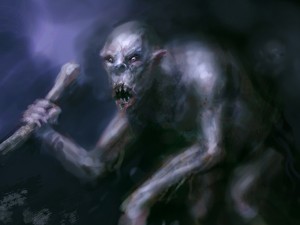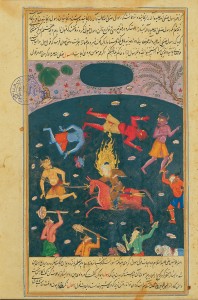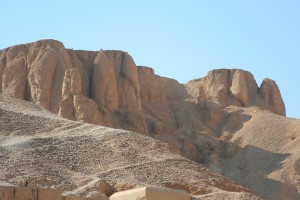Hurray, you’re back! Or you missed the first part and don’t know where you are. The story so far – H P Lovecraft got weird and creative with stories translated from the Arabic by an 18th century French guy, Galland, who wanted to intrigue his readers. Galland messed with the original stuff, made a few things up and developed the Western concept of the ghoul. But he, and William Beckford who followed the trend, were out of the letter H and so they made the goul instead. And none of these were the real ghul. Got that?

Today we travel further back in the Islamic Middle East, accidentally bump into M R James and head towards the Sumerians and Babylonians, with a nod to J R R Tolkien. Why would we do that? Well, because the term ghoul is from the Arabic ghūl, (from ghala, which means “to seize”, or ghal, “kill”), and is etymologically related to gallu, a type of Mesopotamian demon. And the gallu is our ultimate goal(u).
(We should point out that greydogtales articles are made up from dodgy memories, over-enthusiasm and a loft full of junk. Our old Arabian Nights was under a pile of rusty secateurs, one of our other source books has been half-eaten by our labrador, and so on. We don’t recommend entering a scholarly debate armed only with what you read here.)
As we ended Part One with The Thousand and One Nights, we’ll pick up there and give a couple of examples. In the tale The History of Gherib and His Brother Agib, Gherib, a wandering prince, encounters a powerful robber-band/family of ghul, led by Saadan, “the Ghoul of the Mountain”. The ghul here is an immensely strong creature like a man who eats the flesh of those he captures.
O Gherib,’ rejoined the hermit, ‘hadst thou ten thousand, yet shouldest thou not prevail against him, for his name is The-Ghoul-who-eats-men-we-pray-God-for-safety, and he is of the children of Ham. His father’s name was Hindi, who peopled Hind and named it, and he left this son after him, whom he called Saadan the Ghoul. Now, even in his father’s lifetime he was a cruel tyrant and an arrogant devil and had no other food than men’s flesh.
Then pricked out the Ghoul of the Mountain, with a mace on his shoulder, two hundred pounds in weight… Quoth the Ghoul, ‘Jemrcan slew him, captain of the host of King Gherib, prince of cavaliers, and I roasted and ate him, for I was anhungred.’
(Payne translation)
Saadan is converted to Islam, and becomes one of Prince Gherib’s staunchest warriors. In these post-Islamic versions of the old tales, the concept of monsters/ evil-doers embracing God is not uncommon, unlike Western stories of vampires etc.
In The Prince and the Ogress, the ogress is a ghul which leads men astray and back to her lair where she can feed on his flesh. In order to do the waylaying, some if not all ghul have the ability to appear fair in form. In this tale, the ghul appears as an attractive young woman in the wasteland – so shapeshifting can be one of their powers.
So the prince rode after the animal until it disappeared from view somewhere in the desert; and the prince was at a loss, not knowing which way to go, until he saw a young girl weeping above the track which he followed. He asked who she was and she answered: ‘I am the daughters of one of the kings of Hind… I fell from my beast without any noticing. Now I am lost and alone and very sorrowful.
(Mardrus/Mathers translation)
The female type, properly ghula, may seduce or even marry a man before consuming his flesh. In this particular case, the girl/ghul eventually turns into the ogress that she is and leads the prince into some ruins with the intention of feeding her brood (echoes of Whitehead’s story mentioned last time).
How far the shapeshifting goes is debatable. Some say that the ghul can take the form of a hyena, which is of course both a hunter and a scavenger; others that the ghul can take the form of the last person they ate. Like ghul, hyenas are considered in Arabic folklore to be treacherous beasts, and believed by some to be incarnations of jinn. We’ll mention the jinn again in a minute.
It seems likely that this hyena connection is at least partly responsible for both the notion that ghul scavenge and eat dead bodies, and the fact that later ghoul depictions such as H P Lovecraft’s include the dog-like heads. Hyenas have hugely powerful jaws, enabling them to make short work of even large bones.
Back to the plot, and the true nature of the ghul/ghula. Again from Ahmed K. Al-Rawi (The Arabic Ghoul and its Western Transformation):
Throughout different historical and religious periods, the character of the ghoul remained the same, being represented as an ugly human-like monster that dwelt in the desert and secluded locations, in order to delude travellers by lighting a fire and thus leading them astray. In some cases, this creature was said to have killed travellers.
This links to the concept of the will of the wisp common in the folk tales of so many countries – something which lures travellers from the safe path and to their doom. In many Western tales this involves people being drawn into forests or treacherous marshes – in Arabian tales the ghul performs the same role in deserts, ruined cities and mountainous terrain.

A traditional ghul therefore, rather than being a creature which lairs under cemeteries, and which crouches in broken coffins getting an easy dinner, is more a symbolic creature covering a number of ideas:
- the fear of getting lost in wild and lonely places
- the danger and possible brutality of strangers
- the horror/distaste associated with the consumption of human flesh
Given the number of times that that the ghul is a ghula, a female, we also wonder if the storytellers were saying something else as well – either that young men are thick and easily led astray, or that women are devious and not to be followed. Who knows?
(As an aside, last time we talked about the term ghoul being used in Western communities to describe an unhealthy interest in misfortune and death. More in keeping with the nature of ghul appetites, in colloquial Arabic the word may be used to describe a greedy or gluttonous individual.)
In Islamic circles the ghul was most commonly a fiendish type of jinn believed to be sired by Iblis, the equivalent of the Devil. If you didn’t know, jinn can be good or evil, and have the choice to accept a single benevolent (you hope) God or deny him, just like humans. You’ll remember that Saadan the ghul, who we mentioned above, was able to convert and become a ‘jolly good chap’. And evil jinn, in human form, as hyenas or even when somehow in possession of a human, can supposedly be driven away by reciting certain passages of the Quran – a simplified rite of exorcism.

We recently read a very confused article which decided that the Quran was blasphemous because King Solomon was said, therein, to have consorted with demons. This involves a fundamental misunderstanding of the nature of the jinn as a people with free will. We’re not taking religious sides here, by the way, only looking at various texts and scriptures which might explain how things fit together.
What the Quran talks about is that “the wind was made subservient to Solomon, and he could control it of his own will, and that the jinn also came under Solomon’s control. The jinn helped strengthen Solomon’s reign, building for him monuments, houses of worship, artwork, and reservoirs.” And in tales of Solomon’s ring, which some say was bejewelled, the fourth jewel gave him dominion over the jinn, and was inscribed “There is no GOD but GOD, and Muhammad is His messenger.”
Reading this reminded us of two M R James’ stories – Canon Alberic’s Scrap-Book (1894) and An Episode of Cathedral History (1914). In the first story, an antiquarian finds a sepia drawing of King Solomon in his court, with a monstrous creature laid before the king:
At first you saw only a mass of coarse, matted black hair; presently it was seen that this covered a body of fearful thinness, almost a skeleton, but with the muscles standing out like wires. The hands were of a dusky pallor, covered, like the body, with long, coarse hairs, and hideously taloned. The eyes, touched in with a burning yellow, had intensely black pupils, and were fixed upon the throned King with a look of beast-like hate.
On the back of the drawing is found the attribution: The dispute of Solomon with a demon of the night. James goes on to write:
I have never quite understood what was Dennistoun’s view of the events I have narrated. He quoted to me once a text from Ecclesiasticus: ‘Some spirits there be that are created for vengeance, and in their fury lay on sore strokes.’ On another occasion he said: ‘Isaiah was a very sensible man; doesn’t he say something about night monsters living in the ruins of Babylon? These things are rather beyond us at present.’
Rather neat, as those ‘night monsters living in the ruins of Babylon’ will come up next time.

In the second story, we have another creature of hair and horror – ‘Black it was,’ he’d say, ‘and a mass of hair, and two legs, and the light caught on its eyes.’
The widow of a former old verger, a pensioner of the Chapter of Southminster, was visited by dreams, which she retailed to her friends, of a shape that slipped out of the little door of the south transept as the dark fell in, and flitted — taking a fresh direction every night — about the Close, disappearing for a while in house after house, and finally emerging again when the night sky was paling. She could see nothing of it, she said, but that it was a moving form: only she had an impression that when it returned to the church, as it seemed to do in the end of the dream, it turned its head: and then, she could not tell why, but she thought it had red eyes. Worby remembered hearing the old lady tell this dream at a tea-party in the house of the chapter clerk. Its recurrence might, perhaps, he said, be taken as a symptom of approaching illness; at any rate before the end of September the old lady was in her grave.
The story ends with the words IBI CUBAVIT LAMIA, from a 5th century version of Isaiah , which goes:
et occurrent daemonia onocentauris et pilosus clamabit alter ad alterum ibi cubavit lamia et invenit sibi requiem
The translation is: “And demons shall meet with monsters, and one hairy one shall cry out to another; there the lamia has lain down and found rest for herself…”.
Traditions referred to many lamiae or night monsters; these were folkloric monsters similar to vampires and succubi that seduced young men and then fed on their blood. The lamia concept therefore shares much with the myth of the ghula, including a habit of dwelling in lonely and mountainous places, and feasting on men they have entrapped. In this they match the night-spirits and lilitu of Baylonian myth.
Although we’ve spent a bit of time on the Abrahamic stuff, we now have to remind ourselves that the roots of the ghul are pre-Christian and pre-Islamic. Not only are some of the stories based on polytheistic beliefs about wandering spirits, including Bedouin folklore, but we can travel much further back yet, to fabled Babylon – as we will, eventually…
(Our thanks also to Scott Connors, who nearly derailed us in the middle of writing the above by providing far more scholarly sources, including his own essay on the ghoul. We don’t seem to be at huge variance, but if you’re interested in the ghoul in late 19th and 20th century weird/supernatural literature, you might enjoy his essay in Icons of Horror and the Supernatural. Unfortunately it’s now rather expensive to get hold of.)
####
Our ‘fun’ ending, which shows you what sort of fun you get at our house, is about something we fell over when putting together the final part of this article (to follow soon). Poking about in Mesopotamian myths, we came across the Lugale tale, also known as Ninurta’s Exploits. It’s an epic telling of how the warrior-god Ninurta wages war against one of his enemies, to wit Asag, who is described as:
a warrior who knows no fear — the Asag, a child who sucked the power of milk without ever staying with a wet-nurse, a foster-child, O my master — knowing no father, a murderer from the mountains
And we couldn’t help thinking, hmm, Tolkien was a well-read cove. Is it possible that this was the root of his monstrous orc Azog the defiler, a ‘murderer from the mountains’? That was the fellow who took over Moria or Khazad-Dum and slew the dwarf-king Thror. There are a few similarities, but it may be us getting carried away. We usually do.
Asag, you see, was a gallu. Remember, ghoul = ghul = gallu.
####
In the third and absolutely, definitely, no-question-about-it final part of our ghul feature some time next week, we go full Mesopotamian…




